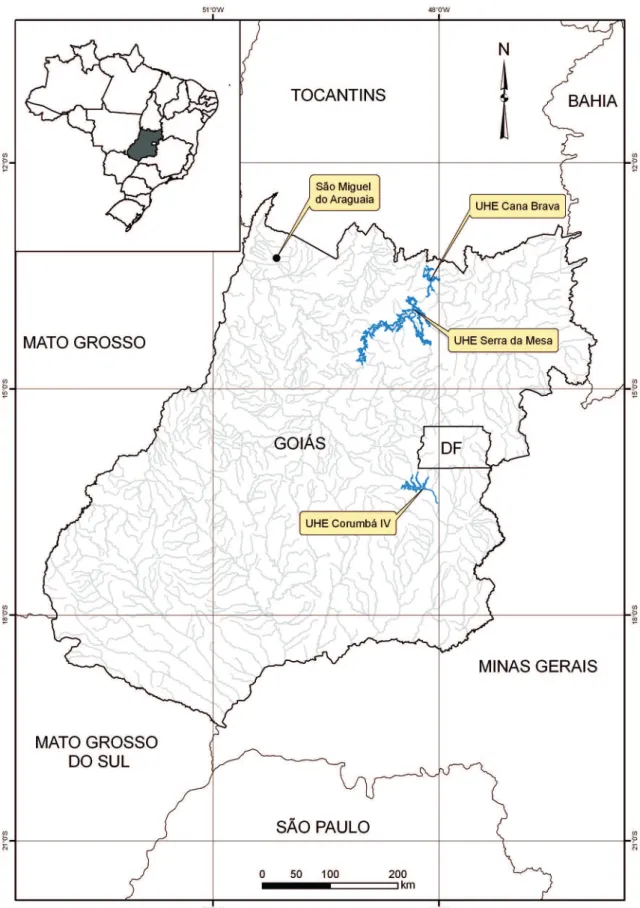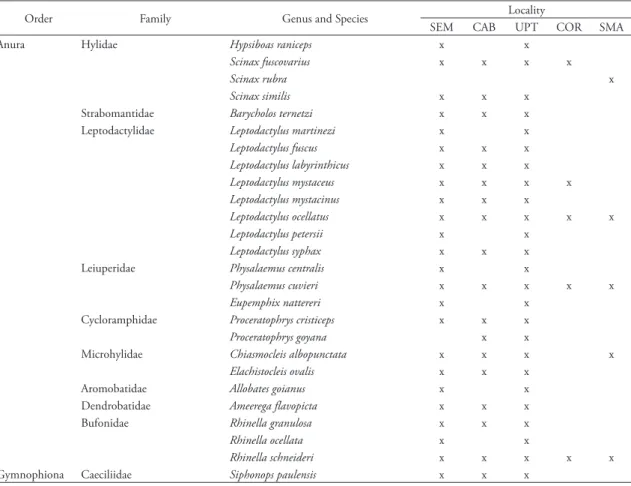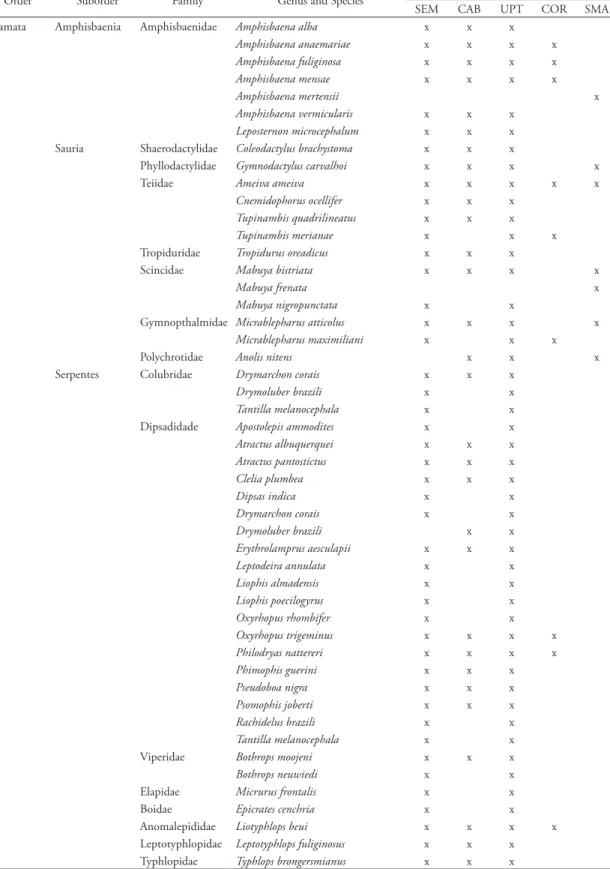A H
U T
L A. M
1D B. F
2H L R S
3N J S J.
1,3,4,5ABSTRACT
Termite mounds are known to offer refuge and microhabitats to a great variety of invertebrates and vertebrates. In the valley of the upper Tocantins River, within areas of influence of hydroelectric power plants 4,000 termite mounds were surveyed to evaluate the diversity of amphibians and reptiles using these environments. Surveys in termite mounds from two other areas (Corumbá River and Araguaia River basins) were used for comparative purposes. The results for termitaria in the upper Tocantins river valley revealed nine families, 13 genera, and 25 species of amphibians, and 16 families, 32 genera, and 47 species of squamate reptiles. Compared to a general herpetofaunal list of the region, the data indicate that between 30.6% and 56.8% of the species use termitaria.
Keywords: Amphibians; Reptiles; Termite Mounds; Cerrado.
INTRODUCTION
Termite mounds, or termitaria, are a distinctive component to the landscape of a variety of habitats worldwide, particularly xeric biomes and provide refuge for smaller animals via physical cover and in maintaining more constant internal humidities and temperatures than the surrounding environment (Pomeroy & Service, 1986). In African woodland habitats, termite mounds add to the heterogeneity
and complexity of the environment, increasing both biodiversity and environmental carrying capacity (Flemming & Loveridge, 2003).
Worldwide, herpetofauna have been linked to ter-mite mounds through a number of non-mutually ex-clusive associations: (1) by living permanent or tempo-rarily in termitaria, (2) by breeding within or on them, or (3) by frequenting the mounds to feed on termites and other invertebrates living there (e.g., Magnusson
et al., 1985; Murray & Schramm, 1987; Ehmann et al.,
Systema Naturae Consultoria Ambiental Ltda. Rua 58, nº 217, Jardim Goiás. 74810-250, Goiânia, GO, Brasil. Atlanta Botanical Garden. Center for Conservation. 1345 Piedmont Ave. Atlanta, Georgia, 30309. USA.
Universidade Católica de Goiás, Departamento de Biologia. Avenida Universitário, 1.440, Setor Universitário, 74605-010, Goiânia, GO. Brasil.
Mestrado em Ciências Ambientais e Saúde. Universidade Católica de Goiás. Rua 232, nº 128, 3º andar, Área V, Setor Universitário. 74605-140, Goiânia, GO, Brasil.
Corresponding author: E-mail: herp@terra.com.br; njsj@ucg.br 1.
2. 3.
4.
1991; Wikramanayake & Dryden, 1993; Griffiths & Cristian, 1996; Gandolfi & Rocha, 1998; Carter, 1999; Peña, 2000; Flemming & Loveridge, 2003).
The Cerrado of Brasil is a seasonally xeric tropi-cal savannah peppered with termite mounds and ac-commodates 23% of all known Neotropical termite species (Brown, 1996; Raw, 1998; Cavalcanti & Joly, 2002 (and sources therein)), several of them be-ing mound buildbe-ing (Dombe-ingos & Gontijo, 1996; Peña, 2000). Mounds often accommodate complex invertebrates assemblages including: multiple ter-mite species – ranging as high as 14 species in one mound (Domingos & Gontijo, 1996), ant colonies (Mill, 1981), scorpions (Lourenço, 1975), spiders (Lourenço, 1978), beetles and their larvae (Bechara
et al., 1999), as well as opilionids, mites, and often dense populations of roaches (Blatodea) (pers. obs.). These resources increase the attractiveness of termite mounds to herpetofauna, particularly to ant and ter-mite specialists. The protective environment inside of a mound is likely another attractive feature. Further-more, considering that the Cerrado can experience temperature swings exceeding 35°C within a twenty-four hour window (Baptista, 1998). For these reasons, we initially hypothesized that the herpetofauna of ter-mite mounds is diverse.
In accordance with Brazilian law, hydroelec-tric power companies must pay for pre-flood faunal surveys as well as for subsequent rescue programs to remove wildlife from flooded habitat upstream of hydroelectric dams. One year prior to the flood-ing of three power plant river valleys (Serra da Mesa, Cana Brava, and Corumbá IV) on the Tocantins and Corumbá Rivers of the Brazilian states of Goiás and Tocantins, we broke termite mounds open and took inventory of the wildlife in them.
Prior to and during the rescue programs, we compiled faunal lists for the habitats. When water impoundments flood habitat, nearly all terrestrial vertebrates are exposed, including fossorial and be-haviorally cryptic species. These events provided op-portunities to create thorough faunal lists for the af-fected regions. These lists were the material to which we compared our termite mound findings.
MATERIAL AND METHODS
Study Area
The collecting efforts were carried out in three sites under the direct influence of hydroelectric power plants (UHE) reservoirs included in environmental impact
mitigation projects under our responsibility. All field work was done between 6 and 12 months prior to the filling of the reservoirs. The sites are located at the upper Tocantins River and included contiguous reservoir areas of UHEs Serra da Mesa (13°46’26”S and 48°20’33”W) and Cana Brava (13°21’45”S and 48°10’04”W). For comparative purposes we used the data from UHE Co-rumbá IV (16°19’38”S and 48°11’11”W) located on the upper Corumbá River valley a secondary tributary of the Paraná River and the data from a site at the Mu-nicipality of São Miguel do Araguaia (13°15’58”S and 50°09’17”W) on the Araguaia River valley in north-western state of Goiás (Peña, 2000) (Figure 1).
Collecting
Termite mounds (TM) were opened using picks and shovels. A first cut was made on the upper base of a mound (surface level) pulling out the aerial part of the structure. From this point the site was excavated at a 20 to 30 cm out of the external limit of the mound till the loose soil was reached (Figure 2). A total of 4,530 TMs were examined as follows: a) UHE Serra da Mesa (SEM) – 2,500 TMs (July 1996); b) UHE Cana Brava (CAB) – 1,500 TMs (July 1999); c) UHE Corumbá IV (COR) – 350 TMs (July 2005); d) São Miguel do Araguaia (SMA) – 180 TMs (November 2000). All herpetofaunal specimens found within ter-mitaria were collected and identified on the spot or in a laboratory facility of each UHE. Vouchers (UHEs Serra da Mesa, Cana Brava, and Corumbá IV) were deposited in the herpetological collection of the Cen-tro de Estudos e Pesquisas Biológicas (CEPB) of the Universidade Católica de Goiás (UCG).
Data Analysis
Using complete faunal lists compiled from pre-flooding surveys for each power plant locality (SEM and CAB) (Silva Jr. et al., 2005), we were able to compare our termite mound faunal lists and deter-mine simple percentages of herpetofauna from each locality that inhabit termitaria. We also combine our list of herpetofauna with a list produced through an unpublished Master’s thesis (Peña, 2000).
RESULTS
At each location, a greater percentage of amphibians than reptiles were found to inhabit termitaria (60 to 85%). For the localities combined as the Upper To-cantins River Valley (Serra da Mesa and Cana Brava), 25 species of amphibians (one gymnophionan and 24
anurans), representing nine families and two orders, were recorded from termitaria. For Serra da Mesa we recorded 13 genera and 24 species, with seven exclu-sive species (Hypsiboas raniceps, Leptodactylus martine-zi, Leptodactylus petersii, Physalaemus centralis, Eupem-phix nattereri, Allobates goianus, and Rhinella ocellata), and for Cana Brava 10 genera and 18 species, with one exclusive species (Proceratophrys goyana). The site of COR listed four families, four genera, and five spe-cies with all spespe-cies also found in the upper Tocantins river valley (UPT). At São Miguel do Araguaia, Peña (2000) listed five families, five genera, and five species, with one exclusive species (Scinax rubra) (Table 1).
From the same mounds, 49 squamate reptile species were recorded, representing 15 families. The UPT presented a total of 15 families, 32 genera, and 47 species, with a contribution of 45 species of SEM (17 exclusive: Tupinambis merianae, Mabuya nigro-punctata, Micrablepharus maximiliani, Apostolepis assi-milis, Apostolepis flavotorquata, Apostolepis ammodites.,
TABLE 1: Amphibian species from the termite mounds of the Upper Tocantins River Valley. Four localities are represented: SEM = Serra da Mesa: upper Tocantins River: Goiás: Brazil; CAB = Cana Brava: upper Tocantins River: Goiás: Brazil; UPT = Upper Tocantins River Valley (data combined); COR = Corumbá IV: Corumbá River: Goiás: Brazil; SMA = São Miguel do Araguaia: Araguaia River: Goiás: Brazil. Data from São Miguel do Araguaia is included from Peña (2000).
Order Family Genus and Species Locality
SEM CAB UPT COR SMA
Anura Hylidae Hypsiboas raniceps x x
Scinax fuscovarius x x x x
Scinax rubra x
Scinax similis x x x
Strabomantidae Barycholos ternetzi x x x Leptodactylidae Leptodactylus martinezi x x
Leptodactylus fuscus x x x
Leptodactylus labyrinthicus x x x
Leptodactylus mystaceus x x x x
Leptodactylus mystacinus x x x
Leptodactylus ocellatus x x x x x
Leptodactylus petersii x x
Leptodactylus syphax x x x
Leiuperidae Physalaemus centralis x x
Physalaemus cuvieri x x x x x
Eupemphix nattereri x x
Cycloramphidae Proceratophrys cristiceps x x x
Proceratophrys goyana x x
Microhylidae Chiasmocleis albopunctata x x x x
Elachistocleis ovalis x x x
Aromobatidae Allobates goianus x x
Dendrobatidae Ameerega flavopicta x x x
Bufonidae Rhinella granulosa x x x
Rhinella ocellata x x
Rhinella schneideri x x x x x
Gymnophiona Caeciliidae Siphonops paulensis x x x
TABLE 2: Reptile species from the termite mounds of the Upper Tocantins River Valley. Four localities are represented: SEM = Serra da Mesa: upper Tocantins River: Goiás: Brazil; CAB = Cana Brava: upper Tocantins River: Goiás: Brazil; UPT = Upper Tocantins River Valley (data combined); COR = Corumbá IV: Corumbá River: Goiás: Brazil; SMA = São Miguel do Araguaia: Araguaia River: Goiás: Brazil. Data from São Miguel do Araguaia is included from Peña (2000).
Order Suborder Family Genus and Species Locality
SEM CAB UPT COR SMA Squamata Amphisbaenia Amphisbaenidae Amphisbaena alba x x x
Amphisbaena anaemariae x x x x
Amphisbaena fuliginosa x x x x
Amphisbaena mensae x x x x
Amphisbaena mertensii x
Amphisbaena vermicularis x x x
Leposternon microcephalum x x x
Sauria Shaerodactylidae Coleodactylus brachystoma x x x
Phyllodactylidae Gymnodactylus carvalhoi x x x x
Teiidae Ameiva ameiva x x x x x
Cnemidophorus ocellifer x x x
Tupinambis quadrilineatus x x x
Tupinambis merianae x x x
Tropiduridae Tropidurus oreadicus x x x
Scincidae Mabuya bistriata x x x x
Mabuya frenata x
Mabuya nigropunctata x x
Gymnopthalmidae Micrablepharus atticolus x x x x
Micrablepharus maximiliani x x x
Polychrotidae Anolis nitens x x x
Serpentes Colubridae Drymarchon corais x x x
Drymoluber brazili x x
Tantilla melanocephala x x
Dipsadidade Apostolepis ammodites x x
Atractus albuquerquei x x x
Atractus pantostictus x x x
Clelia plumbea x x x
Dipsas indica x x
Drymarchon corais x x
Drymoluber brazili x x
Erythrolamprus aesculapii x x x
Leptodeira annulata x x
Liophis almadensis x x
Liophis poecilogyrus x x
Oxyrhopus rhombifer x x
Oxyrhopus trigeminus x x x x
Philodryas nattereri x x x x
Phimophis guerini x x x
Pseudoboa nigra x x x
Psomophis joberti x x x
Rachidelus brazili x x
Tantilla melanocephala x x
Viperidae Bothrops moojeni x x x
Bothrops neuwiedi x x
Dipsas indica, Drymarchon corais, Leptodeira annulata, Liophis almadensis, Liophis poecilogyrus, Oxyrhopus rhombifer, Rachidelus brazili, Tantilla melanocephala, Bothrops neuwiedi, Micrurus frontalis, and Epicrates cenchria), and 30 species of CAB (two exclusive: Anolis chrysolepis and Drymoluber brazili). The site of COR listed eight species and Peña (2000) cited nine species for SMA (two exclusive: Amphisbaena mertensii and
Mabuya frenata) (Table 2).
The data gathered from termitaria revealed a 56.8% similarity of amphibian and 50.0% of squa-mate reptile species compared to the known herpe-tofauna of the Upper Tocantins River Valley (Silva Jr.
et al., 2005). Separate termitaria data demonstrate a 54.5% similarity for amphibians and 45.9% for rep-tiles in SEM, and 40.9% for amphibians and 30.6% for reptiles in CAB compared to the same list. The low diversity recorded for COR and SMA is most probably a direct relationship to collecting efforts.
DISCUSSION
Our results suggest that termite mounds are im-portant resources for significant portions of the her-petofauna of the upper Tocantins River Valley. They support our initial hypothesis that termite mounds would prove herpetologically diverse. Between 30% and 50% of the herpetofauna known from each of our study sites were also found in termite mounds. Future studies may demonstrate termite mounds are critical components to the environment in maintaining her-petological diversity.
There are species we predicted we would find in termite mounds which were conspicuously absent from our tallies at the end of the surveys. Among them was the microhylid anuran, Dermatonotus muelleri.
This fossorial frog has an appropriate ecological niche for termite mound existence but was not encountered within termitaria.
Similarly there are several other species of am-phibians and reptiles known for the region that might also use termitaria as a microhabitat but we were not able to confirm them and therefore suggest treating the results as preliminary.
RESUMO
Termiteiros são conhecidos por oferecer refúgio e micro habitats para uma grande variedade de invertebrados e vertebrados. Aproveitando trabalhos realizados na área de influência de usinas hidrelétricas no vale do rio
Tocantins, inspecionamos avaliamos 4.000 termiteiros visando determinar os anfíbios e répteis que se utilizam desses ambientes. Resultados obtidos em duas outras áreas (bacias dos rios Corumbá e Araguaia) foram utilizadas como comparação. No vale do alto rio Tocantins nove famílias, 13 gêneros e 25 espécies de anfíbios e 15 famílias, 32 gêneros e 47 espécies de Squamata foram encontrados nos termiteiros. Esses dados indicam que entre 30.6% e 56.8% das espécies da herpetofauna utilizam termiteiros.
Palavras-chave: Anura; Gymnophiona; Squamata; Termiteiros; Cerrado.
ACKNOWLEDGMENTS
The authors are grateful to the Pró-Reitoria de Pós-Graduação e Pesquisa of the Universidade Católi-ca de Goiás for field support.
REFERENCES
Baptista, G.M.G. 1998. Caracterização climatológica do Distrito Federal. In: Inventário Hidrogeológico e dos Recursos Hídricos
e Superficiais do Distrito Federal. IEMA/SEMATEC/UnB,
Brasília, p. 187-208.
Bechara, E.J.H.; Colepicolo-Neto, P.; Viviani, V.R.; Barros, M.P. & Costa, C. 1999. Colors and biological functions of beetle bioluminescence. Anais da Academia Brasileira de Ciências,
71(2):169-174.
Brown Jr., K.S. 1996. Diversity of Brazilian Lepidoptera: history of study, methods for measurement, and use as indicators for genetic, specific, and system richness. In: Bicudo, C.A. & Menezes, N.A. (Eds.), Biodiversity in
Brazil: a first approach. CNPq/Instituto de Botânica, São
Paulo, p. 121-154.
Carter, D.B. 1999. Nesting and evidence of parental care by the lace
monitor Varanus varius. Mertensiella, 11:137-147.
Cavalcanti, R.B. & Joly, C.A. 2002. Biodiversity and conservation priorities in the Cerrado region. In: Oliveira, P.S. & Marquis R.J. (Eds.), The Cerrados of Brazil. Columbia University Press, New York, p. 351-367.
Domingos, D.J. & Gontijo, T.A. 1996. Multi-occupation of termite mounds in cerrado vegetation in south-eastern Brazil. Revista
Brasileira de Biologia, 56(4):717-723.
Ehmann, H.; Swan, G.; Swan, G. & Smith, B. 1991. Nesting, egg incubation and hatching by the heath monitor Varanus rosenbergi
in a termite mound. Herpetofauna, 21(1):17-24.
Flemming, P.A. & Loveridge, J.P. 2003. Mombo woodland termite mounds: resource islands for small vertebrates? Journal of the
Zoological Society of London, 259:161-168.
Gandolfi, S.M. & Rocha, C.F.D. 1998. Orientation of thermoregulating Tropidurus torquatus (Sauria: Tropiduridae) on termite mounds in an open area of south-eastern Brazil.
Amphibia-Reptilia, 19(3):319-323.
Griffiths, A.D. & Cristian, K.A. 1996. The effects of fire on the frillneck lizard (Chlamydosaurus kingii) in northern Australia.
Lourenço, W.R. 1975. Preliminary studies of the scorpions of the Federal-District Brazil. Revista Brasileira de Biologia,
35(4):679-682.
Lourenço, W.R. 1978. Notes on the biology of Acanthoscurria atrox Araneae Theraphosidae. Revista Brasileira de Biologia,
38(1):161-164.
Magnusson, W.E.; Lima, A.P. & Sampaio, R.M. 1985. Sources of heat for nests of Paleosuchus trigonatus and a review of crocodilian
nest temperatures. Journal of Herpetology, 19(2):199-207.
Mill, A.E. 1981. Observations on the ecology of Pseudomyrmex termitarius hymenoptera formicidae in Brazilian savannas.
Revista Brasileira de Entomologia, 25(4):271-274.
Murray, G.W. & Schramm, D. 1987. A Comparative study of the diet of the wedge-snouted sand lizard Meroles cuneirostris Strauch and the sand diving lizard Aporosaura achietae Bocage lacertidae
in the Namib desert. Madoqua, 15(1):55-62.
Peña, A.P. 2000. Importância dos termiteiros para a comunidade de pequenos vertebrados em uma área de várzea na região do
Cerrado. (Dissertação de Mestrado). Universidade Federal de
Goiás, Instituto de Ciências Biológicas, Goiânia.
Pomeroy, D.E. & Service, M.W. 1986. Tropical Ecology. Longman Scientific & Technical, New York.
Raw, A. 1998. Relatório sobre número de insetos, a riqueza de
espécies e aspectos zoogeográficos nos cerrados. Workshop Ações
Prioritárias para conservação da biodiversidade do Cerrado e Pantanal. Conservation International/Fundação Biodiversitas/ Universidade de Brasília. Brasília.
Silva Jr., N.J.; Silva, H.L.R.; Rodrigues, M.T.U.; Valle, N.C.; Costa, M.C.; Castro, S.P.; Linder, E.T.; Johansson, C. & Sites Jr., J.W. 2005. A fauna de vertebrados do alto rio Tocantins em áreas de usinas hidrelétricas. Estudos – Vida e
Saúde, 32(1):57-101.
Wikramanayake, E.D. & Dryden, G.L. 1993. Thermal ecology of habitat and microhabitat use by sympatric Varanus bengalensis
and Varanus salvator in Sri Lanka. Copeia, 1993:709-714.
Recebido em: 22.07.2008 Aceito em: 23.04.2009 Publicado em: 30.06.2009
Seção
de
Publicações
d
o
M


